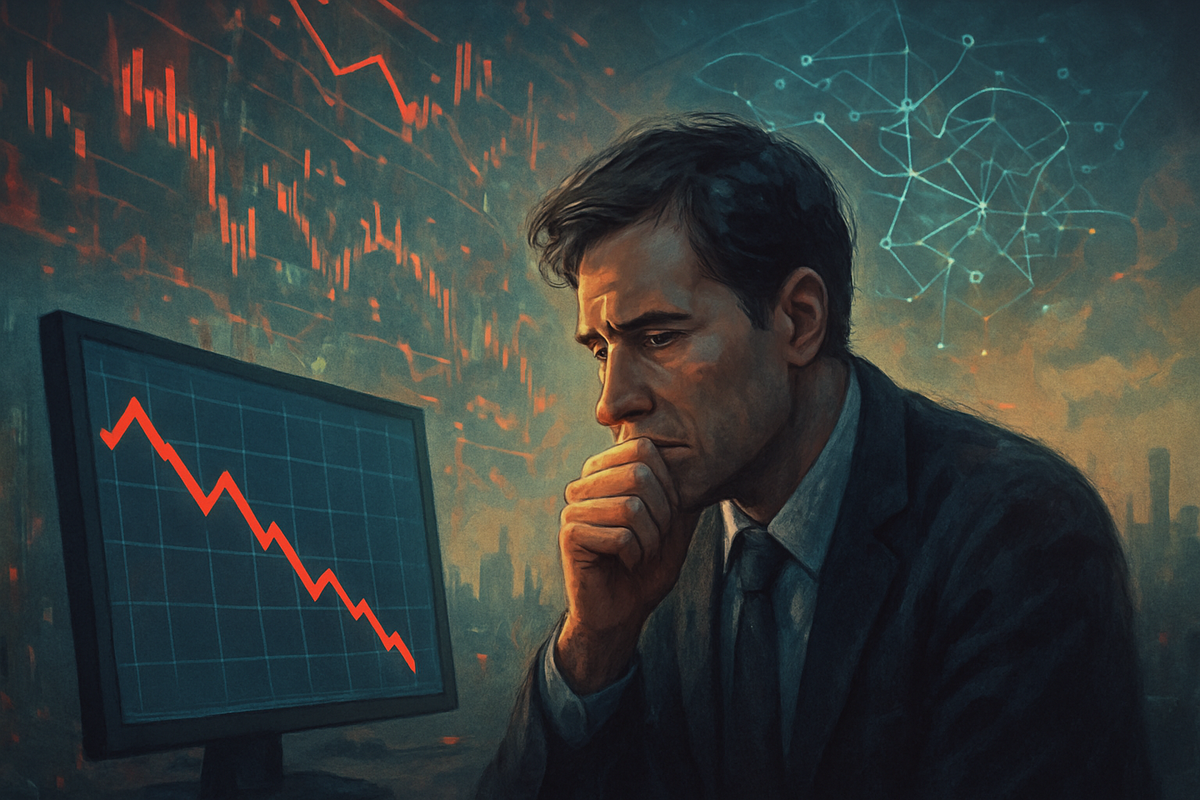
The past week, from November 1st to November 8th, 2025, has witnessed a significant shift in global market sentiment, moving decisively towards a "risk-off" stance. Investors are grappling with heightened volatility and a pervasive sense of unease, as U.S. and international equity markets have experienced broad declines, snapping recent winning streaks. This downturn marks a critical juncture for financial markets, which are now navigating a complex landscape of mixed economic signals, geopolitical tensions, and a re-evaluation of high-flying asset valuations. The prevailing mood suggests a market bracing for potential turbulence, with capital preservation taking precedence over aggressive growth pursuits.
Detailed Market Dynamics and Underlying Concerns
The market's pronounced shift towards caution was evident across major indices. The S&P 500 concluded the week lower, posting a 2.72% loss by November 7th, with its information technology sector experiencing its worst week since April, down 4.2%. The Nasdaq Composite suffered an even more significant blow, recording its worst weekly performance in seven months, while the Dow Jones Industrial Average also registered declines. Internationally, European and Asian markets mirrored this downward trend, with European stocks seeing back-to-back weekly losses and Asian markets experiencing their poorest week since August. The CBOE Volatility Index (VIX), often dubbed Wall Street's "fear gauge," surged, reflecting the escalating uncertainty.
Several mixed signals are contributing to this cautious sentiment. The labor market presents a conflicting picture: while ADP reported some stabilization, a report from Challenger, Gray & Christmas revealed the largest jump in layoffs for October in over 20 years, signaling a potentially faster economic deceleration than anticipated. The Federal Reserve's recent 25-basis-point interest rate cut was overshadowed by Chair Powell's remarks, indicating "strongly differing views" among officials on future cuts, adding to investor uncertainty. Corporate earnings season has been a mixed bag, with many companies beating forecasts but facing resistance to high valuations, particularly in the tech sector.
Market breadth has also shown cracks, with gains heavily concentrated in a few mega-cap technology stocks. Technical indicators like the "Nasdaq Titanic Syndrome" and "Hindenburg Omen" have flashed, historically preceding market weakness. Compounding these issues, a prolonged U.S. government shutdown, now in its fifth week, has delayed the release of critical economic data, forcing investors to rely on alternative sources and further fueling uncertainty. Consumer confidence has plummeted to a three-year low, according to the University of Michigan, signaling extreme pessimism and raising concerns about future consumer spending. The primary concerns driving investor behavior are the elevated valuations of Artificial Intelligence (AI) related stocks, fears of a weakening economy leading to a potential recession, and persistent geopolitical instability in Ukraine and the Middle East, alongside US-China trade rivalries.
Companies Navigating the Storm: Winners and Losers
In this "risk-off" environment, characterized by heightened volatility, AI valuation concerns, and a weakening economy, certain public companies are poised to either benefit from their defensive nature or suffer due to their sensitivity to economic cycles and speculative valuations.
Potential Winners: Companies providing essential goods and services, often referred to as "defensive" stocks, tend to thrive during periods of economic uncertainty. Consumer Staples companies, whose products consumers need regardless of economic conditions, are well-positioned. Examples include Procter & Gamble (NYSE: PG), known for household and personal care products; The Coca-Cola Company (NYSE: KO), with its stable beverage demand; and Walmart Inc. (NYSE: WMT), a discount retailer that often sees increased demand as consumers seek value. Healthcare companies like Johnson & Johnson (NYSE: JNJ), Pfizer Inc. (NYSE: PFE), and Amgen Inc. (NASDAQ: AMGN) also exhibit resilience, as demand for medical care and pharmaceuticals remains constant. Similarly, Utilities companies such as Consolidated Edison Inc. (NYSE: ED), providing essential services like electricity and water, offer stability and predictable cash flows.
Potential Losers: Companies highly sensitive to economic cycles, discretionary spending, or those with valuations primarily driven by speculative growth are vulnerable. The Technology Sector, especially those with high AI valuations, faces significant headwinds. Companies like Nvidia (NASDAQ: NVDA), a leading AI chipmaker, Microsoft (NASDAQ: MSFT), and Palantir Technologies (NYSE: PLTR) have seen their stocks dip amidst concerns over unsustainable valuations. Broadcom (NASDAQ: AVGO) and Advanced Micro Devices (NASDAQ: AMD) are also susceptible to declines linked to AI demand and valuation fears. Consumer Discretionary companies, which sell non-essential goods and services, are likely to suffer as consumer confidence and disposable income decline. This includes automakers like Ford Motor Company (NYSE: F), airlines such as Delta Air Lines (NYSE: DAL), and hospitality giants like Walt Disney (NYSE: DIS), as travel and leisure spending are often among the first cuts during economic downturns. Industrial and Materials companies, tied to overall economic activity and business investments, such as Rio Tinto (LSE: RIO.UK) and SAF-Holland (XTRA: SFQ.DE), also face challenges from reduced demand and tighter credit conditions.
Wider Significance: Echoes of Past Bubbles and Future Shifts
The current market volatility and prevailing "risk-off" sentiment are not isolated events but rather fit into broader industry trends and carry significant wider implications. The intense scrutiny on AI valuations draws striking parallels to historical periods of market exuberance, most notably the Dot-Com Bubble of 2000-2001. While the underlying technology (AI versus the early internet) differs, the core principle of speculative bubbles forming around transformative technologies, followed by a reassessment of unsustainable valuations, remains highly relevant. Analysts point to the current market concentration in a few mega-cap AI stocks as even higher than during the dot-com era, raising questions about the sustainability of the broader market rally.
This period is also highlighting a critical shift in market breadth. Gains have been heavily concentrated in a select few AI-related giants, suggesting that a significant portion of the market is not participating in the rally, which is often a precursor to broader market weakness. Consequently, there's a discernible trend of capital rotation from high-growth, speculative assets towards more stable, defensive holdings. Sectors like utilities, healthcare, and consumer staples are expected to see renewed interest due to their consistent demand and stability, emphasizing a renewed focus on fundamental value and strong balance sheets.
The ripple effects extend across the economic ecosystem. Smaller tech firms and AI startups, especially those without established revenue streams, could face a much tougher fundraising environment. Larger tech companies that have heavily invested in AI might see subpar returns, impacting their valuations. Supply chains reliant on vulnerable tech giants or discretionary consumer spending could face significant headwinds. Increased borrowing costs and reduced liquidity, driven by widespread market fear, could hinder investment and expansion plans across various sectors. Conversely, resilient tech giants might seize opportunities to acquire struggling startups at reduced valuations, leading to further industry consolidation.
From a regulatory and policy perspective, the concerns over market concentration and potential "AI bubbles" could prompt increased scrutiny from financial regulators. This might lead to new policies aimed at safeguarding market stability or curbing speculative excesses, akin to the Dodd-Frank Act enacted after the 2008 financial crisis. Central banks may implement further monetary policy interventions, such as interest rate cuts, to inject liquidity and restore confidence, though high volatility can reduce their effectiveness. Governments might also employ expansionary fiscal policies to stimulate demand. The ongoing U.S. government shutdown further complicates the Federal Reserve's ability to make informed decisions and erodes overall market confidence.
Historical comparisons extend beyond the dot-com bubble to the Great Recession of 2008-2009, which saw significant government and central bank interventions to stabilize economies. While the triggers differ, the potential for substantial fiscal stimulus and monetary policy responses remains a key consideration. Bear markets, historically defined as declines greater than 20%, have frequently been associated with recessions, underscoring the gravity of the current market signals.
What Comes Next: Navigating a Disrupted New Economic Reality
The coming months and years promise a complex and potentially transformative period for the global economy and financial markets, shaped by the interplay of economic headwinds, technological shifts, and evolving policy responses.
In the short-term (next 6-12 months), continued market volatility is highly probable, driven by ongoing central bank decisions, persistent inflation, and evolving geopolitical headlines. Executives from major financial institutions have warned of potential equity market drawdowns of 10% to 20%. However, these market pullbacks could also present selective buying opportunities for long-term investors in fundamentally strong companies or oversold sectors like technology, consumer discretionary, healthcare, industrials, and small-caps. The anticipated monetary policy easing, with expectations of further Fed rate cuts by year-end 2025, could offer some market support, though its impact on inflation remains a critical watchpoint. Geopolitical risks, including potential trade wars and conflicts, remain significant wildcards.
Looking to the long-term (1-5 years and beyond), the global economy is poised for structural shifts. A period of slower global growth and persistent inflation, potentially leading to "stagflationary pressures," is a tangible concern. The rise of economic nationalism, fiscal activism, and the accelerating influence of AI are defining a "disrupted new economic reality." AI and automation are expected to be transformative forces, boosting productivity but also posing challenges such as significant job displacement in low-to-mid skill roles. Sustainable finance is also projected to become a dominant force, with ESG assets under management potentially exceeding $40 trillion by the end of the decade. While U.S. GDP growth is expected to slow through 2026, it could accelerate again in 2027, driven by robust business investment in AI.
Strategic pivots and adaptations will be crucial for both investors and businesses. Investors should consider moving beyond traditional diversification to include assets like gold, infrastructure, and short-dated bonds for enhanced portfolio resilience. Active management and a focus on value stocks, particularly in small-cap segments, are favored. Allocations to alternative investments like distressed debt and hedge funds may offer diversification. Businesses must prioritize AI governance, operational resilience, supply chain localization, and cybersecurity. A shift from pure revenue growth to protecting profitability will be paramount in an environment of higher costs and tighter margins.
Market opportunities may arise from significant market dips, offering attractive entry points for long-term investors in strong companies. Long-term growth trajectories remain robust for sectors like healthcare, social assistance, AI and data-related fields, and the green economy. AI adoption is also expected to drive substantial productivity boosts. However, significant challenges include potential AI-driven job displacement, higher operating costs due to inflation and tariffs, tighter access to capital for smaller AI startups, and ongoing geopolitical and trade tensions impacting global growth.
Potential scenarios range from a challenging "soft landing," where inflation moderates without a severe recession but with persistent challenges, to a mild recession and recovery in 2026. A more adverse scenario of prolonged stagflation (persistent inflation with weak growth) is also a tangible risk. The overarching outcome points to a "disrupted new economic reality" where the global economy becomes increasingly fragmented, and AI drives significant but uneven technological transformation, creating a clear dynamic of winners and losers.
Comprehensive Wrap-Up: Navigating the New Normal
The past week's market performance has served as a stark reminder of the inherent volatility and complexity of global financial markets. The prevailing "risk-off" sentiment, fueled by legitimate concerns over AI valuations, a weakening economy, and geopolitical instability, has pushed markets to a critical juncture. Key takeaways include the fragility of market breadth, the increasing importance of fundamental value over speculative growth, and the potential for significant shifts in capital allocation from high-growth tech to more defensive sectors.
Moving forward, the market is likely to remain turbulent, demanding a more discerning and adaptable approach from investors. The era of easy money and unbridled growth in certain tech segments appears to be giving way to a period where profitability, robust balance sheets, and resilient business models will be paramount. Investors should closely monitor central bank policies, inflation trends, and geopolitical developments, as these will continue to be major drivers of market sentiment. The long-term impact of AI, while transformative, will also need careful consideration regarding its economic and societal implications.
Ultimately, the current environment signals a potential "new normal" characterized by increased caution, a greater emphasis on risk management, and a more selective approach to investment. While challenges abound, this period of re-evaluation also presents opportunities for those who can identify fundamentally strong companies, diversify strategically, and adapt to the evolving economic landscape. What investors should watch for in the coming months are further signals from labor market data, clarity on the Federal Reserve's future interest rate path, and any developments in geopolitical tensions, all of which will shape the trajectory of this dynamic market.
This content is intended for informational purposes only and is not financial advice





